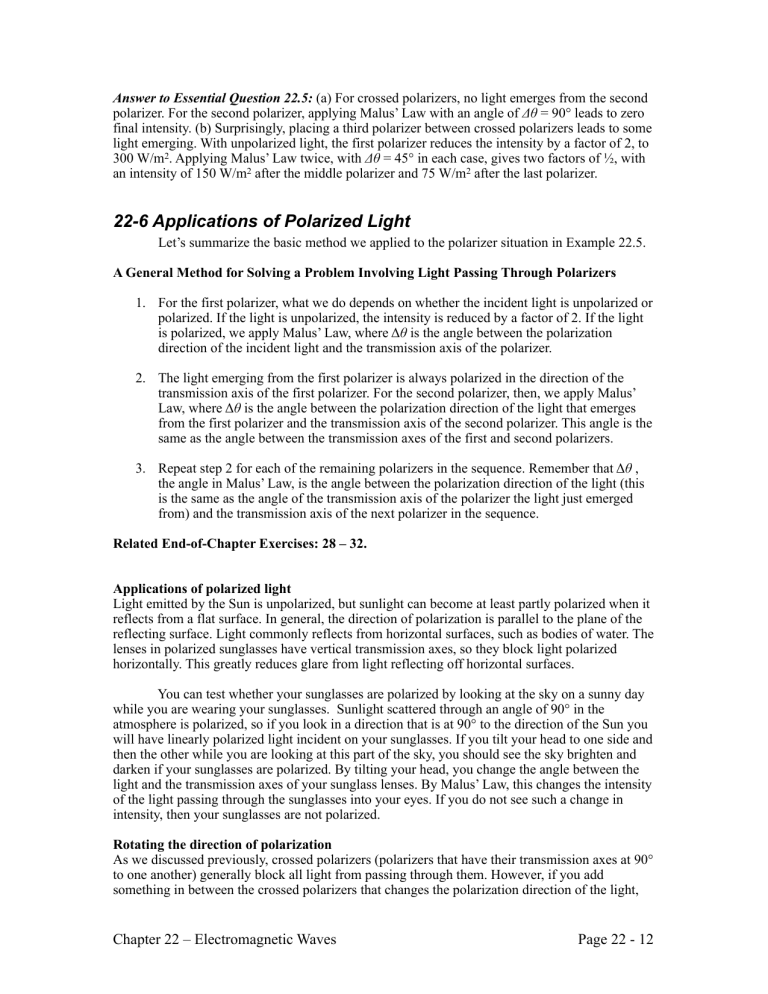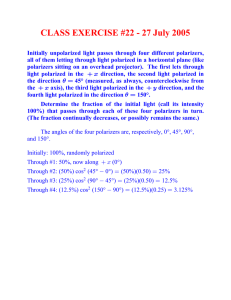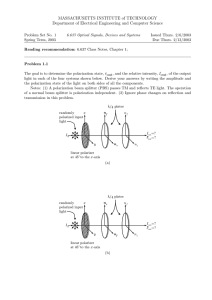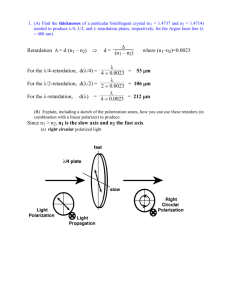22-6 Applications of Polarized Light

Answer to Essential Question 22.5: (a) For crossed polarizers, no light emerges from the second polarizer. For the second polarizer, applying Malus’ Law with an angle of $# = 90° leads to zero final intensity. (b) Surprisingly, placing a third polarizer between crossed polarizers leads to some light emerging. With unpolarized light, the first polarizer reduces the intensity by a factor of 2, to
300 W/m 2 . Applying Malus’ Law twice, with $# = 45° in each case, gives two factors of $ , with an intensity of 150 W/m 2 after the middle polarizer and 75 W/m 2 after the last polarizer.
22-6 Applications of Polarized Light
Let’s summarize the basic method we applied to the polarizer situation in Example 22.5.
A General Method for Solving a Problem Involving Light Passing Through Polarizers
1. For the first polarizer, what we do depends on whether the incident light is unpolarized or polarized. If the light is unpolarized, the intensity is reduced by a factor of 2. If the light is polarized, we apply Malus’ Law, where # # is the angle between the polarization direction of the incident light and the transmission axis of the polarizer.
2. The light emerging from the first polarizer is always polarized in the direction of the transmission axis of the first polarizer. For the second polarizer, then, we apply Malus’
Law, where # # is the angle between the polarization direction of the light that emerges from the first polarizer and the transmission axis of the second polarizer. This angle is the same as the angle between the transmission axes of the first and second polarizers.
3. Repeat step 2 for each of the remaining polarizers in the sequence. Remember that # # , the angle in Malus’ Law, is the angle between the polarization direction of the light (this is the same as the angle of the transmission axis of the polarizer the light just emerged from) and the transmission axis of the next polarizer in the sequence.
Related End-of-Chapter Exercises: 28 – 32.
Applications of polarized light
Light emitted by the Sun is unpolarized, but sunlight can become at least partly polarized when it reflects from a flat surface. In general, the direction of polarization is parallel to the plane of the reflecting surface. Light commonly reflects from horizontal surfaces, such as bodies of water. The lenses in polarized sunglasses have vertical transmission axes, so they block light polarized horizontally. This greatly reduces glare from light reflecting off horizontal surfaces.
You can test whether your sunglasses are polarized by looking at the sky on a sunny day while you are wearing your sunglasses. Sunlight scattered through an angle of 90° in the atmosphere is polarized, so if you look in a direction that is at 90° to the direction of the Sun you will have linearly polarized light incident on your sunglasses. If you tilt your head to one side and then the other while you are looking at this part of the sky, you should see the sky brighten and darken if your sunglasses are polarized. By tilting your head, you change the angle between the light and the transmission axes of your sunglass lenses. By Malus’ Law, this changes the intensity of the light passing through the sunglasses into your eyes. If you do not see such a change in intensity, then your sunglasses are not polarized.
Rotating the direction of polarization
As we discussed previously, crossed polarizers (polarizers that have their transmission axes at 90° to one another) generally block all light from passing through them. However, if you add something in between the crossed polarizers that changes the polarization direction of the light,
Chapter 22 – Electromagnetic Waves Page 22 - 12
some light can get through the system. In Essential Question 22.5, we looked at how adding a third polarizer between the crossed polarizers can result in light being transmitted. However, other transparent materials, such as Karo syrup, bits of mica, some cellophane tape, or clear plastic objects such as plastic forks, when placed between the crossed polarizers also result in light being transmitted. Interestingly, such materials generally affect different wavelengths of light differently, so by varying the thickness of the transparent material the light passes through, colorful patterns can be created. Such patterns have been used to make art installations, such as the one by Austine Wood Comarow at the Museum of Science in Boston, which has everchanging pictures when viewed through a rotating polarizer.
Stress in a material can also affect the extent to which the polarization direction of a light wave passing through the material is rotated. Engineers exploit this material property by placing models between crossed polarizers to study the stress patterns.
Liquid-crystal displays
Another common application of polarized light is in liquid-crystal displays
(LCDs), such as those on digital watches.
You may have noticed that an LCD readout can be unreadable if you look at it through polarized sunglasses. This is because the light coming off the LCD is polarized, and thus can all be absorbed by polarizing sunglasses when the display is at a particular angle. The basis structure of an LCD display is shown in
Figure 22.9(b). Key components are the crossed polarizers, separated by liquid crystals, and the mirror surface at the back.
Light incident on the display from the right first passes through one polarizer, then through layers of liquid crystals. Successive layers of liquid crystals are rotated with respect to one another, and the net effect is that the polarization direction of the light is rotated by
90°. This aligns the light so that it passes through a second polarizer, with its transmission axis perpendicular to the first. The light then reflects off the mirror and reverses the steps, emerging from the sandwich.
Figure 22.9
: (a) Liquid-crystal displays are generally made of seven-segment displays, with different segments being turned on or off to make different numbers. (b) Each segment is formed from a sandwich of crossed polarizers and liquid crystals.
Light entering from the right reflects, and the segment appears bright, when no potential difference is applied. Applying a potential difference causes light to be blocked, and the segment to go dark.
By applying a potential difference to the transparent electrodes, however, the liquid crystal layers un-twist, so the light’s polarization axis is not rotated. In that case, all the light is blocked by the second polarizer, and that part of the readout looks dark. In a typical LCD readout, numbers are formed using seven-segment displays, in which the appropriate potential difference is applied across a given segment to turn it black, if desired, or no potential difference is applied to make the segment bright, like the background of the display.
Related End-of-Chapter Exercises: 2, 5, 57, 58.
Essential Question 22.6: Light passes through two polarizers. The intensity of the light emerging from the second polarizer is 65% of the intensity of the incident light. The incident light is either unpolarized or linearly polarized. Which is it?






